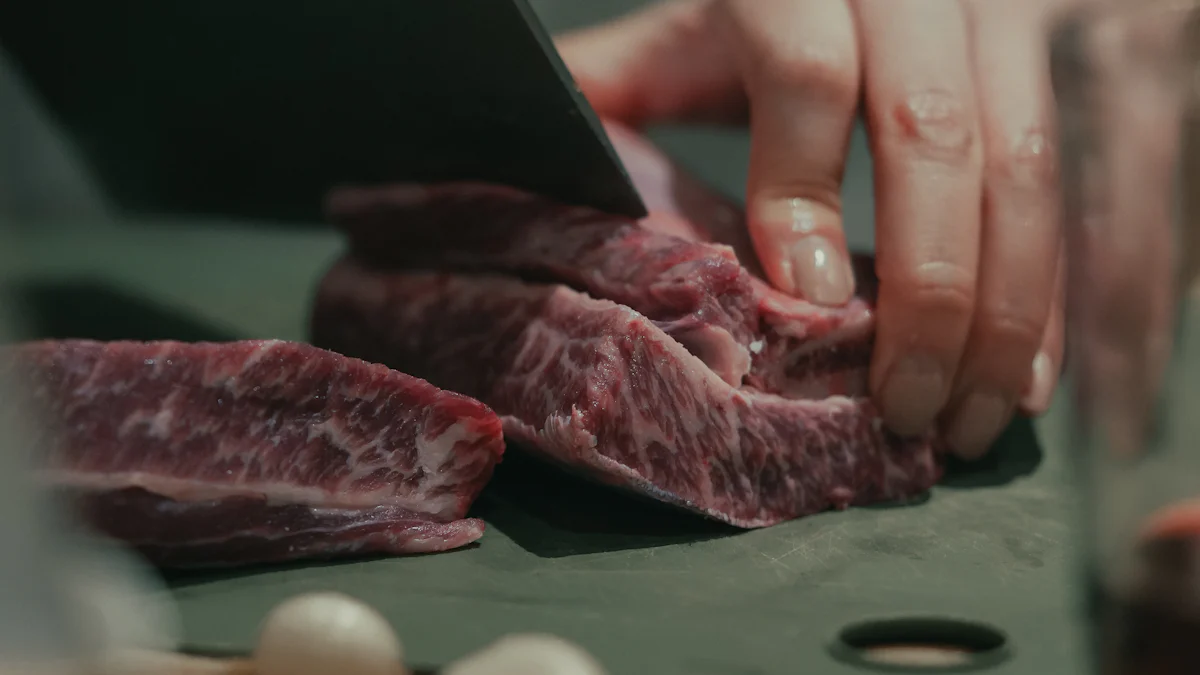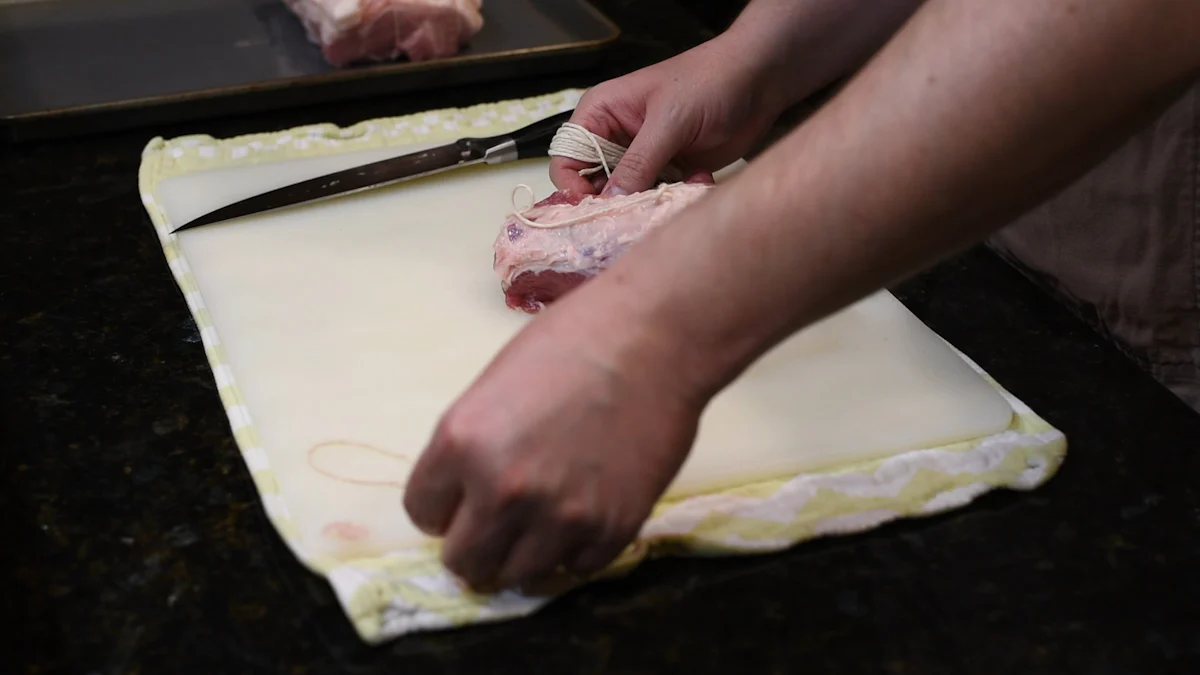Tips for Using a Meat Cutting Machine

Learning how to use a meat cutting machine can revolutionize your food preparation process, but it’s crucial to prioritize safety and precision. Ensuring a stable setup and practicing proper handling techniques will help you achieve consistent, high-quality slices while minimizing risks. Accidents, though uncommon, often occur due to neglecting essential precautions. For instance, research indicates that improper use of food machinery can result in serious hand injuries. To prevent such incidents, always use safety gear like cut-resistant gloves. By understanding how to use a meat cutting machine correctly, you not only safeguard yourself but also consistently produce superior results.
Key Takeaways
- Prioritize safety by using cut-resistant gloves and inspecting your machine for damage before use.
- Ensure a stable and clean workspace to enhance efficiency and reduce the risk of accidents.
- Chill meat before slicing for cleaner cuts and always cut against the grain for tender results.
- Choose the right blade for the type of meat you're slicing to achieve optimal performance.
- Regularly clean and maintain your machine to ensure hygiene and prolong its lifespan.
- Explore the versatility of your meat cutting machine by using it for vegetables, cheeses, and bread.
- Follow the manufacturer's guidelines for assembly and maintenance to keep your machine in top condition.
Setting Up Your Meat Cutting Machine

Setting up your meat cutting machine properly is the first step to ensuring safe and efficient operation. A well-prepared workspace, correct assembly, and adherence to safety precautions will make your slicing experience smoother and more enjoyable.
Preparing the Workspace
Before you even plug in your machine, take a moment to prepare your workspace. A stable and clean environment reduces risks and enhances your efficiency.
- Ensure a stable, level surface: Place your machine on a sturdy, flat surface. This prevents slipping or wobbling during use, which could lead to accidents or uneven cuts.
- Keep the area clean and clutter-free: Clear away any unnecessary items around the machine. A tidy workspace minimizes distractions and helps you focus on the task at hand.
"A stable cutting surface is essential to prevent the meat from slipping while slicing," as highlighted by food safety experts. This simple step can make a big difference in your overall experience.
Assembling the Machine
Proper assembly is crucial for the machine to function as intended. Follow these steps to ensure everything is set up correctly:
- Follow the manufacturer’s instructions: Every machine is different, so always refer to the manual provided. Many manufacturers also offer online guides with detailed instructions.
- Double-check all parts: After assembling, inspect the machine to confirm that every part is securely in place. Loose components can cause malfunctions or even damage the equipment.
Some machines, like Meat Cutting Machines, come with enhanced safety features such as guards and emergency stop buttons. Make sure these are installed and functioning properly before you begin.
Safety Precautions Before Use
Safety should always be your top priority when using a meat cutting machine. Taking a few extra minutes to inspect and prepare can prevent accidents.
- Inspect the machine for damage: Look for any signs of wear, loose parts, or damage. If something seems off, address it before turning on the machine.
- Wear appropriate safety gear: Protect your hands with cut-resistant gloves. These gloves provide an added layer of safety, especially when handling sharp blades.
According to maintenance guidelines, always clean and inspect your machine before its first use and after each session. This ensures hygiene and keeps the equipment in good working condition.
By following these steps, you’ll not only learn how to use a meat cutting machine effectively but also create a safer and more efficient workspace. Proper setup is the foundation for achieving consistent, high-quality results every time.
Techniques for Effective Cutting
Mastering the art of slicing meat with precision can elevate your cooking game. By preparing the meat properly, selecting the right blade, and operating the machine with care, you’ll achieve consistent, tender cuts every time. Let’s dive into the techniques that will help you get the most out of your meat cutting machine.
Preparing the Meat
The way you prepare your meat before slicing plays a huge role in the final result. A few simple steps can make the process smoother and the slices more uniform.
- Chill the meat for a firmer texture: Cold meat is easier to handle and slice. Place it in the refrigerator for a while before cutting. This step ensures cleaner cuts and prevents the meat from becoming mushy.
- Trim excess fat or bones: Remove any unwanted fat or bones before slicing. This not only protects your machine but also ensures smooth operation without interruptions.
- Cut against the grain for tender slices: Always identify the grain of the meat and slice perpendicular to it. Cutting against the grain shortens the muscle fibers, making the meat tender and easier to chew.
Studies show that slicing against the grain is especially effective for tougher cuts like skirt or flank steak. It’s a simple trick that makes a big difference in texture.
Choosing the Right Blade
The blade you use can significantly impact the quality of your slices. Different blades are designed for different types of cuts, so choosing the right one is essential.
- Use serrated blades for tougher cuts or frozen meat: Serrated blades grip and cut through dense or frozen meat more effectively. They’re perfect for handling challenging textures.
- Opt for smooth blades for delicate or thin slices: Smooth blades work best for softer meats or when you need paper-thin slices. They glide through the meat effortlessly, giving you precise results.
Switching between blades might seem tedious, but it ensures you get the best performance from your machine. Always match the blade to the type of meat you’re slicing.
Operating the Machine
Using the machine correctly is key to achieving consistent results and maintaining safety. Follow these tips to operate your meat cutting machine like a pro.
- Use slow, controlled motions: Don’t rush the process. Move the meat steadily through the blade to maintain precision and avoid accidents.
- Avoid forcing the meat through the blade: Let the machine do the work. Forcing the meat can damage the blade or motor, reducing the machine’s lifespan.
- Clean and sanitize between different types of meat: Cross-contamination can ruin your meal and pose health risks. Always clean and sanitize the machine thoroughly before switching between raw and cooked meats or different types of meat.
Food safety experts emphasize the importance of cleaning your machine to prevent cross-contamination. This simple habit keeps your food safe and your machine in top condition.
By following these techniques, you’ll not only learn how to use a meat cutting machine effectively but also ensure that every slice meets your expectations. Whether you’re preparing a family dinner or hosting a barbecue, these tips will help you deliver perfectly sliced meat every time.
Maintenance and Cleaning Tips

Proper maintenance and cleaning of your meat cutting machine are essential for ensuring its longevity and optimal performance. Neglecting these tasks can lead to hygiene issues, reduced efficiency, and even safety hazards. Let’s explore the best practices to keep your machine in top shape.
Cleaning the Machine
Cleaning your meat cutting machine after every use is non-negotiable. It not only ensures hygiene but also prevents food buildup that could affect the machine’s performance.
- Unplug the machine before cleaning: Always disconnect the machine from the power source to avoid accidents. Safety should come first.
- Disassemble removable parts: Take apart components like the blade, food chute, and carriage table. Wash them thoroughly with warm, soapy water to remove any residue.
- Sanitize the machine: Use an appropriate sanitary cleaning solution to disinfect all surfaces. Pay special attention to the blade, ring guard mount, and slicer handle. This step ensures your machine remains safe for food preparation.
"Wipe away from the blade to avoid cutting yourself," experts recommend. Also, avoid using steel wool on metal parts, as it can scratch the surface.
For machines with stainless steel construction, cleaning becomes even easier. Standard cleaning tools and solutions work perfectly, making the process hassle-free.
Caring for the Blade
The blade is the heart of your meat cutting machine. Keeping it sharp and well-maintained ensures precise cuts and extends its lifespan.
- Sharpen the blade regularly: A dull blade not only affects the quality of your slices but also puts extra strain on the machine. Manufacturers often suggest sharpening the blade every four hours of continuous use.
- Store the blade in a safe, dry place: When not in use, keep the blade in a dry environment to prevent rust. Moisture can quickly damage the blade, reducing its efficiency.
Over-sharpening can cause excessive wear on the blade, leading to premature replacement. Follow the manufacturer’s guidelines to strike the right balance.
Routine Maintenance
Routine maintenance keeps your machine running smoothly and prevents unexpected breakdowns. A little effort goes a long way in preserving its functionality.
- Lubricate moving parts: Apply lubrication to the transport rod and carriage rod as recommended by the manufacturer. This reduces friction and ensures smooth operation.
- Inspect the machine periodically: Check for loose or damaged parts. Replace them promptly to avoid further issues. Regular inspections help you catch problems early and maintain the machine’s efficiency.
Professionals advise having your machine inspected regularly to ensure all components are in good working condition. This proactive approach saves you time and money in the long run.
By following these maintenance and cleaning tips, you’ll not only learn how to use a meat cutting machine effectively but also ensure it remains a reliable tool in your kitchen. A well-maintained machine delivers consistent results and enhances your overall food preparation experience.
Maximizing Utility
Your meat cutting machine isn’t just for slicing meat. With a little creativity, you can unlock its full potential and make it a versatile tool in your kitchen. From preparing vegetables to experimenting with different types of meat, here’s how you can maximize its utility.
Using the Machine for Other Ingredients
A meat cutting machine can handle more than just meat. Its precision and efficiency make it perfect for slicing other ingredients with ease.
- Slice vegetables like cucumbers or zucchini: Achieve uniform cuts for salads, stir-fries, or garnishes. The machine ensures consistent thickness, which is hard to achieve with a knife. This saves time and gives your dishes a professional touch.
- Use it for cheeses or bread: Create even slices of cheese for sandwiches or charcuterie boards. For bread, the machine delivers clean cuts without crushing the loaf. This is especially useful for soft or freshly baked bread.
Pro Tip: When slicing non-meat items, clean the machine thoroughly beforehand. This prevents any lingering meat residue from affecting the flavor or hygiene of your other ingredients.
Tips for Different Types of Meat
Different meats require different approaches. By adjusting your technique, you can get the best results for every cut.
- Adjust the thickness settings: For deli meats like ham or turkey, use thinner settings to create perfect slices for sandwiches. For steaks or roasts, opt for thicker cuts to suit your recipe. Most machines come with adjustable settings, so take advantage of this feature to customize your slices.
- Experiment with slicing cooked versus raw meat: Raw meat is easier to slice when chilled, as it holds its shape better. Cooked meat, on the other hand, requires a gentler touch to maintain its texture. Try slicing roast beef or turkey breast after cooking to see how the machine enhances presentation and portioning.
"Investing in a high-quality meat cutting machine can significantly enhance your culinary experience," as noted by professionals. Machines with adjustable settings and durable blades make it easy to tackle various types of meat with precision.
By exploring these tips, you’ll not only learn how to use a meat cutting machine effectively but also discover its versatility. Whether you’re preparing a gourmet meal or a quick snack, this tool can simplify your process and elevate your results.
Mastering how to use a meat cutting machine starts with proper setup, effective techniques, and regular maintenance. These steps not only ensure safety but also improve efficiency and food quality. By keeping your machine clean, sharpening the blade, and inspecting parts regularly, you’ll enjoy consistent results every time. Don’t stop at meat—explore its versatility by slicing vegetables, cheeses, or bread. With these tips, you’ll transform your kitchen experience, creating dishes that look and taste better. Take care of your machine, and it will take care of your slicing needs.
FAQ
What are the benefits of using meat cutting machines?
Meat cutting machines bring efficiency and precision to your kitchen. They help you achieve consistent slices, saving time and effort compared to manual cutting. These machines also prioritize safety with features like protective guards and intuitive controls, reducing the risk of accidents. Whether you're slicing deli meats or preparing steaks, a meat cutting machine ensures professional-quality results every time.
What should you consider when buying a meat cutting machine?
When choosing a meat cutting machine, focus on its horsepower, type of drive, and ease of maintenance. Machines with higher horsepower handle frequent use better, making them ideal for busy kitchens. Decide between belt-driven or gear-driven models based on your needs—gear-driven machines often last longer. Also, look for a machine that's easy to clean and repair to ensure hassle-free operation.
How does the VEVOR Meat Cutting Machine stand out?
The VEVOR Meat Cutting Machine simplifies the slicing process with its powerful performance. It handles tough cuts effortlessly, saving you time and energy. This machine is a reliable investment for any kitchen, offering durability and consistent results. If you're looking for a tool that combines efficiency with ease of use, the VEVOR model is a great choice.
Why are meat slicing machines safer for employees?
Meat slicing machines are designed with safety in mind. Advanced features like protective guards and revolving loaders minimize direct contact with sharp components. These features reduce the risk of injuries, making them a safer option for employees in commercial kitchens. By using these machines, you create a safer work environment while maintaining productivity.
Can a meat cutting machine handle other ingredients?
Yes, many meat cutting machines are versatile enough to slice other ingredients. You can use them for vegetables like cucumbers or zucchini, achieving uniform cuts for salads or stir-fries. They also work well for cheeses and bread, providing clean, even slices. Just make sure to clean the machine thoroughly before switching between different types of food.
How do you maintain a meat cutting machine?
Regular maintenance keeps your machine running smoothly. Always unplug it before cleaning, and disassemble removable parts for thorough washing. Sanitize all surfaces to ensure hygiene. Sharpen the blade regularly and store it in a dry place to prevent rust. Lubricate moving parts as recommended by the manufacturer, and inspect the machine periodically for wear and tear.
What safety gear should you use with a meat cutting machine?
Cut-resistant gloves are essential when operating a meat cutting machine. These gloves protect your hands from accidental cuts while handling sharp blades. Some users also prefer wearing aprons to keep their clothing clean and safe. Prioritizing safety gear ensures a worry-free slicing experience.
Is it worth investing in a commercial meat cutting machine?
If you frequently prepare large quantities of meat, a commercial meat cutting machine is a worthwhile investment. These machines offer high horsepower and durable construction, making them suitable for heavy-duty use. They save time, improve efficiency, and deliver consistent results, making them a valuable addition to any kitchen.
How do you choose the right blade for your machine?
The blade choice depends on the type of meat you're slicing. Serrated blades work best for tougher cuts or frozen meat, while smooth blades are ideal for delicate or thin slices. Switching blades might seem tedious, but it ensures the best performance for each task. Always match the blade to the specific requirements of your recipe.
Can a meat cutting machine improve food quality?
Absolutely! A meat cutting machine ensures uniform slices, which enhances the presentation and cooking consistency of your dishes. By cutting against the grain, you achieve tender, flavorful meat. The precision and control offered by these machines elevate the overall quality of your meals, making them a must-have tool for any kitchen.
See Also
Comprehensive Instructions for Operating a Hair Clipper
Beginner's Guide to Understanding Die Cutting Machines
Essential Steps for Beginners Using Die Cutting Machines
